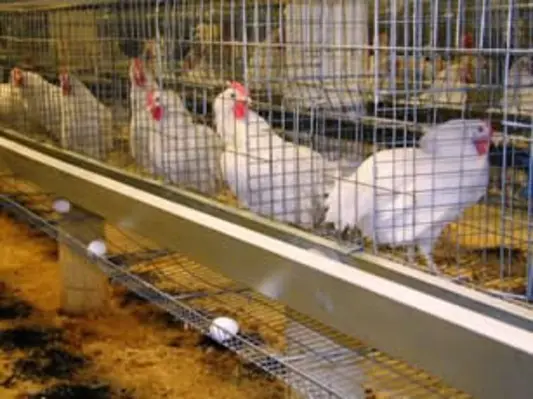The route to improving flock performance lies in good litter management. Poultry litter too dry or too wet stresses the flock and generally results in reduced profits. And, producers can best manage litter conditions in the poultry house by taking a disciplined approach to the watering system. This means preventing leaks, maintaining the correct drinker height and regularly adjusting the pressure to ensure the birds are getting the maximum amount of water without wetting the litter.
Producers should strive for 20 to 25 per cent litter moisture content. This makes the litter friable or easily crumbled. By maintaining litter in this condition, producers keep the poultry house more hygienic. Besides promoting healthier birds, this strategy permits the producer to reduce dependence on antibiotics.
Producers gain the advantage of spending less on medications and producing birds more appealing to consumers because of reduced antibiotic use.
Litter above the 25 per cent moisture content threshold can chill the birds. It also provides an ideal home for pathogens, such as E. coli, coccidiosis and salmonella.
Wet litter creates ammonia releases that can damage a birdís trachea, making it more susceptible to disease. Humans can detect ammonia at around 20 parts per million (ppm). Concentrations higher than that, around 50 to 100 ppm, cause the human eye to burn and tear. For chickens, the situation is even worse. Concentrations of 50 to 100 ppm can cause blindness in poultry. Even at a level of 5 ppm (undetectable to the human nose), ammonia can irritate the protective lining of a chick’s respiratory system, making it more susceptible to disease. As a practical matter, a producer cannot eliminate ammonia but should strive to keep it below 25 ppm.
Other drawbacks of wet litter include increased foot lesions, breast blisters, skin burns and scabby areas. Any disease in the birds takes feed energy away from meat production to fight off the condition. Additionally, any injury or unhealthy condition increases downgrades and condemnations.
Litter that is too dry has its own innate problems, such as dehydration in new chicks. Dusty air conditions also promote respiratory disease. Both of these result in increased production problems and reduced performance.
Optimum litter conditions
To achieve optimum litter conditions, producers need to carefully manage their drinking system.
First, the producer should regularly walk the poultry house, keeping on the lookout for leaking drinkers and caked litter. Several factors can cause drinkers to leak:
• Daily wear and tear takes its toll. When installing a drinking system in a house, or when replacing old drinkers, producers should make sure they employ a high-quality system that will yield them a good return on their investment.
• Buildup of sediment in the lines can cause leaks. Producers can best prevent sediment buildup by installing a filter at the beginning of the drinking system. The filter should use a 5-10 micron cartridge. Additionally, a regular program of flushing the water lines will reduce sediment.
• Biofilm buildup also can cause leaks. Biofilm results from bacteria attaching to the pipesí walls in a drinking system. As producers introduce interventions of medications and vitamins, bacteria find an ideal breeding ground in glucose and other nutrient-enriched bases used for the interventions. Additionally, enclosed watering systems operate on low pressure, providing little turbulence to dislodge this buildup. A high-pressure flush breaks up the biofilm.
Producers also need to pay attention to system pressure and drinker height. Drinkers set too low will result in water spills. Drinkers placed too high will inhibit birds from getting all the water they need. Adjust both of these settings as often as needed to ensure the birds are getting sufficient water without wetting the floor.
Pressure adjustment
To determine if drinkers discharge an appropriate amount of water, again examine litter conditions. If very dry litter conditions exist under the drinker line, increase the water pressure until a slight dampness develops. Then make a slight pressure adjustment back down. More than a slight dampness under each drinker means unnecessarily high water pressure, giving the birds more water than they can consume with each peck. In this case, reduce the water pressure by at least 30 percent.
The first few days of a new flock are critical. If the chicks do not drink or cannot find the water, they will rapidly dehydrate. On the first day, place the chicks close to the drinkers. Lower the drinkers to the point where the chicks actually run into the trigger pin. Also, have light bright enough to attract chicks to the metal pins.
As the birds find the drinkers, raise the lines slightly, encouraging the chicks to stretch their necks. By the second or third day, drinker height should encourage the chicks to peck in about a 45-degree angle. Chickens rely on gravity to drink because of a split in the upper hard palate of the beak that allows air into the nasal passages. This prevents the birds from forming a vacuum in their mouths and they must raise their heads to allow the water to flow into their crops.
As the birds age, continue to raise the drinkers. By four weeks, the drinker height should require the birds to peck at about a 50- to 55-degree angle. (A straight line from the bird’s feet to its beak determines the angle.) Higher drinkers force the birds to elevate their breasts and stretch their necks, leading to inadequate consumption. Some producers set the drinkers so high the birds must jump to strike the pin. This only encourages more spillage.
Finally, consider the type of litter used. Producers tend to use litter most economically available in their area. Different types of litter have different absorption qualities. Litter from pine or other softwood shavings, for example, absorbs more moisture than litter from hardwood shavings. Some types of litter, such as straw and newspaper, may absorb but not promote evaporation very well. Generally with this type of litter, compensate by increasing the litter thickness.
Source: Ziggity Systems, Inc.





